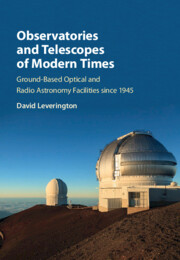 Observatories and Telescopes of Modern Times
Observatories and Telescopes of Modern Times This book is a history of modern astronomical observatories and their telescopes. As such it covers the history of optical/infrared and radio/microwave observatories and telescopes that have been built since the Second World War. I have tried to cover the most innovative and trend-setting professional facilities and, as a result, I have excluded a discussion of most of the optical observatories established before the war even though some of them were still adding telescopes after 1945. This is because most of their new telescopes, with few exceptions, were not really innovative.
In many ways, the Palomar Observatory can be seen as the last of the major pre-war optical observatories as its first telescope, its 18/26 inch (46/66 cm) Schmidt, was built in the mid 1930s and its two main telescopes, the 200 inch (5.1 m) and the large Palomar (Oschin) Schmidt, were largely designed before the war. So maybe it should be excluded from this book, even though building of its two main telescopes was not completed until the late 1940s. But Palomar designs were innovative in many ways, setting the standards for large optical telescopes and observatories for some time to come. Consequently, I have begun my narrative with a brief outline of the design and development of the Palomar Observatory.
Ground-based astronomical observatories these days consist of more than just optical/infrared and radio/microwave facilities. For example, a number of neutrino, cosmic-ray, gamma-ray and gravity-wave observatories have been built, but I have excluded these to avoid complicating the book. Likewise, I have excluded small professional and large amateur facilities, interesting though many of them are, as this would take the book into completely new territory and make it considerably longer.
Discussing the history of professional astronomical observatories has its challenges as there are so many of them and their histories are often interconnected. It is theoretically possible to consider their history as one large interconnected story, but to produce a readable text I would have had to leave out interesting details which, in my opinion, would have made the book less interesting.
To save this book to your Kindle, first ensure [email protected] is added to your Approved Personal Document E-mail List under your Personal Document Settings on the Manage Your Content and Devices page of your Amazon account. Then enter the ‘name’ part of your Kindle email address below. Find out more about saving to your Kindle.
Note you can select to save to either the @free.kindle.com or @kindle.com variations. ‘@free.kindle.com’ emails are free but can only be saved to your device when it is connected to wi-fi. ‘@kindle.com’ emails can be delivered even when you are not connected to wi-fi, but note that service fees apply.
Find out more about the Kindle Personal Document Service.
To save content items to your account, please confirm that you agree to abide by our usage policies. If this is the first time you use this feature, you will be asked to authorise Cambridge Core to connect with your account. Find out more about saving content to Dropbox.
To save content items to your account, please confirm that you agree to abide by our usage policies. If this is the first time you use this feature, you will be asked to authorise Cambridge Core to connect with your account. Find out more about saving content to Google Drive.